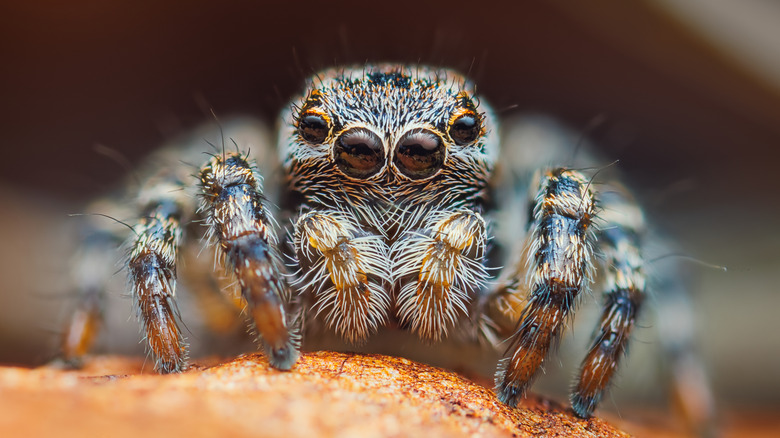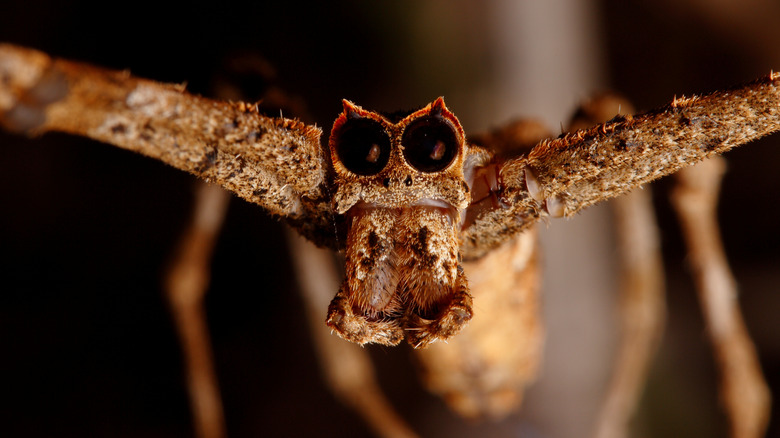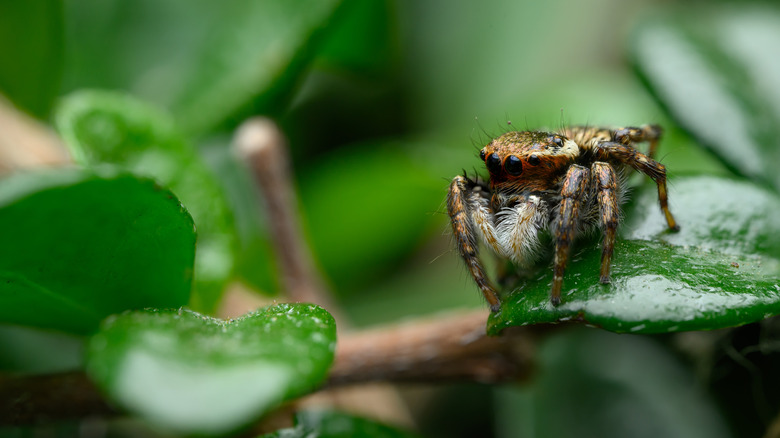The Way Spiders See Is Super Complicated
Spiders have an off-putting reputation, especially when you think about ancient spiders from Australia that are pure nightmare fuel, but their biology can tell us a lot about the natural world. When you think of animals with extraordinary vision, spiders probably don't spring to mind, yet these eight-legged creatures possess one of the animal kingdom's most diverse and specialized visual systems. Most spiders have eight eyes, though some species make do with six or fewer. Despite this ocular abundance, the majority of the world's more than 50,000 spider species have surprisingly poor eyesight, relying instead on their exceptional sensitivity to vibration, touch, and taste to navigate their environments and capture prey.
For most spiders, vision serves primarily to detect light–dark changes — just enough to trigger hunting behavior or to escape from predators. This fact represents one of the common misconceptions about evolution: good enough is often the ultimate goal. Spider eyes are typically arranged in two rows across the front of their carapace (the head–thorax section), and scientists classify them based on their position: anterior (front) or posterior (back) row, and then median (middle) or lateral (side) within each row. What's fascinating is that spiders' "direct" eyes — those in the anterior middle — differ significantly from their "indirect" eyes, those located elsewhere on the carapace.
This matters a great deal in how spiders hunt and survive. Wolf spiders, net-casting spiders, and jumping spiders have all evolved sophisticated eyes that enable them to detect motion, judge distance, and even perceive colors with remarkable accuracy. These visual hunters represent the pinnacle of arachnid eye evolution. From the daylight precision hunting of jumping spiders to the nocturnal ambush strategies of web-weavers, here's how evolution helped everyone's favorite creepy crawlers transform a basic sensory apparatus into a highly specialized tool for survival.
Spiders' specialized vision systems
Ever noticed how a wolf spider's eyes gleam eerily in your flashlight beam while taking out the trash at night? That's no accident; it's the result of their specialized reflector eyes at work. Wolf spiders are primarily twilight hunters, and their four large posterior eyes contain well-developed tapeta — reflective layers that bounce light back through their retinas — providing these nocturnal predators with sharper, more detailed vision.
Even more impressive are the "search-light" eyes of net-casting spiders, particularly those in the genus Deinopis, aptly nicknamed "ogre-faced spiders" for their menacing appearance. Two of their rear eyes have evolved into enormous forward-facing lenses that function like twin spotlights, just one of many unique adaptations spiders have evolved to fit their natural habitats. But what's most remarkable about the spider is that these eyes have an F-number of 0.58. F-numbers denote the amount of light throughput in a lens (either in a camera or an eye), and a figure of 0.58 in these spiders means they can gather light more efficiently than cat or even owl eyes. Perhaps most impressive is the fact that a light-sensitive membrane in the spider's eyes is actually built every night, vanishing with the dawn.
Then you've got the adorable day-dwelling jumping spider, which takes visual specialization in yet another direction. Their eyes are built like tiny telescopes consisting of two lenses at either end of a fluid-filled tube that magnifies images onto their retina. According to Nathan Morehouse from the University of Cincinnati, jumping spiders see the world better than dogs, cats, and other small-sized animals within a specific focal range. If you've ever gotten up close and personal with a jumping spider and wondered why they seem to be studying you, that's because they are.
Jumping spiders' multi-purpose color vision
Jumping spiders don't just see clearly, they see smart. There are over 5,000 different jumping spider species, and these species frequently see color differently than their relatives. Overall, though, jumping spiders' eyes work as a coordinated team, each set offering a different function to help the spider survive. When movement is detected in the periphery, their side eyes give them a kind of unfocused image of the object.
But the spider's principal eyes — the big, round eyes at the front and center of its carapace — are where the magic really happens. As we've seen, these eyes' two lenses help increase the amount of detail passing onto the spider's retinas, leading to them being able to see in sharp detail within a limited distance. Amazingly, the spiders can use their muscles to swivel these fluid-filled tunnels to remain focused on their prey. Once they've decided to attack, their rear-located side eyes allow them to ascertain their target's position and distance, letting them line up a precision leap to capture their lunch.
But acuity is only part of the story. Researchers at the University of Cincinnati and the University of Pittsburgh have demonstrated that some jumping spiders possess remarkably advanced color vision, capable of detecting hues from ultraviolet to red — a rare ability among invertebrates. By using microspectrophotometry, a technique that measures how individual cells absorb different wavelengths of light, scientists discovered that these spiders utilize internal red filters to shift green-sensitive photoreceptors into detecting longer wavelengths of light. That means a greater ability to distinguish between poisonous and non-lethal food sources, a distinct advantage for any animal.


